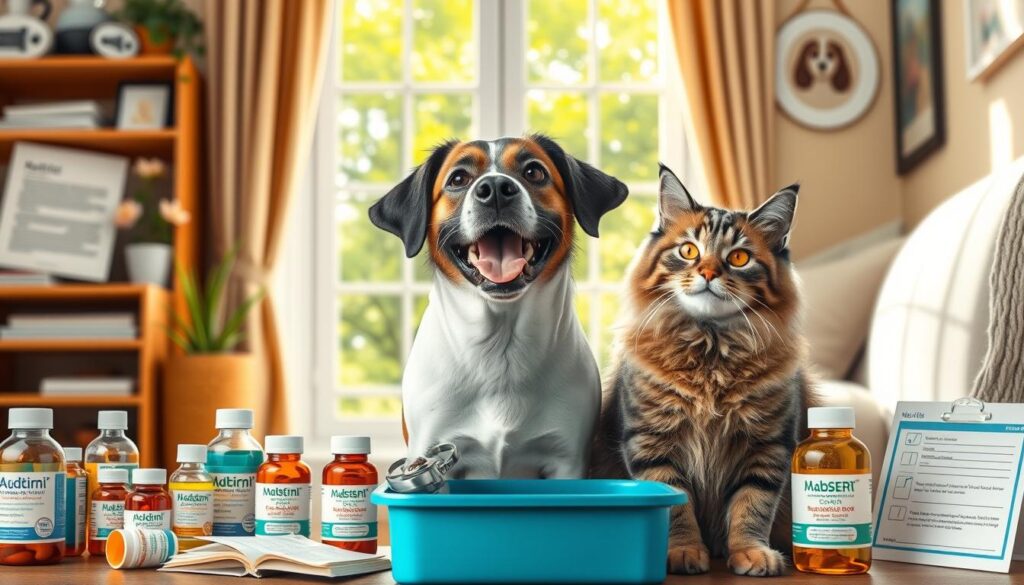Pet insurance benefits and options. Did you know vet bills can quickly pile up? This often leaves pet owners worried about money. Pet insurance is a solution to help with these costs. But, with many plans out there, picking the right one can be tough. This guide will help you understand the benefits and options to protect your pet’s health.
Key Takeaways
- Pet insurance can help offset the cost of veterinary care for accidents and illnesses.
- Plans vary in the types of coverage they provide, from accident-only to comprehensive accident and illness protection.
- Understanding the different policy options, such as wellness plans and deductibles, can help you find the best fit for your pet and budget.
- Reviews and testimonials from other pet owners can provide valuable insights when choosing an insurance provider.
- Considering pet insurance can be a wise investment to ensure your beloved companion receives the care they need.
What is Pet Insurance?
Pet insurance is like health insurance for your pets. It helps pay for vet visits, accidents, and illnesses. This way, you can afford the care your pet needs without breaking the bank.
Types of Pet Insurance Policies
There are three main types of pet insurance:
- Accident and Illness Coverage: This plan covers many health issues, including chronic conditions and medications.
- Accident-Only Coverage: This plan is cheaper and only covers accidents, not illnesses.
- Wellness Plans: These add-ons cover routine vet visits and vaccinations for extra cost.
Why Consider Pet Insurance
Pet insurance gives you peace of mind and financial security. It helps you afford vet care without worrying about costs. With vet bills rising, insurance is a smart choice for your pet’s health.
“92 percent of pet owners with pet insurance find it worth it, according to an Experian survey, yet only 29 percent of pet owners surveyed actually have pet insurance.”
How Pet Insurance Works
Pet insurance helps by paying you back after you’ve paid the vet. You’ll need to send in the bill and some extra paperwork. Then, the insurance company will send you a check for a part of the bill, called the reimbursement rate.
This rate can be from 50% to 90% of the vet bill. It depends on your policy.
Filing a Claim
Filing a claim for pet insurance is easy. First, pay the vet bill. Then, collect the needed info:
- A detailed invoice from the vet, showing what was done and how much it cost
- Any extra papers, like medical records or test results
- Your policy details, like your plan number and contact info
With all this info, you can send in the claim. You can do this online, by mail, or through a mobile app. The insurance company will check it out. If you’re covered, they’ll send you a check in a few days to weeks.
| Reimbursement Rates | Average Monthly Premiums for Dogs | Average Monthly Premiums for Cats |
|---|---|---|
| 50% to 90% of vet bills |
|
|
Remember, how fast and how you get reimbursed can change. Always check your policy and the insurance company’s claim rules.
Coverage Options for Pet Insurance
When looking for pet insurance, you’ll find three main types: accident and illness, accident-only, and wellness plans. Each has its own benefits and costs. Knowing the differences helps you pick the best plan for your pet and your budget.
Accident and Illness Coverage
Accident and illness coverage is the most complete. It covers many unexpected medical costs, like injuries and illnesses. It also includes chronic conditions. This type of coverage helps pay for surgeries, tests, and hospital stays.
Top pet insurance companies like ASPCA, Embrace, and Hartville offer this plan. They have reimbursement rates from 70% to 90% and deductibles from $100 to $1,000.
Accident-Only Coverage
Accident-only coverage is more basic. It only covers injuries from accidents, like broken bones or poisonings. It’s cheaper, especially for older pets or those on a tight budget. But, it doesn’t cover illnesses or ongoing health issues.
MetLife offers accident-only plans. They have reimbursement rates from 50% to 90% and deductibles from $0 to $2,500.
Wellness Plans
Many pet insurance providers also offer wellness plans. These plans cover routine care, like check-ups, vaccinations, and dental cleanings. Pets Best has a wellness plan with a 5-star rating and costs $48 a month. It includes exam fees and a 24-hour vet helpline.
When picking a pet insurance plan, think about your pet’s age, health, and your budget. Accident and illness coverage is the most comprehensive. But, accident-only or wellness plans might be better for some. Always compare policies, read reviews, and understand the details to find the best fit for you and your pet.
| Provider | Coverage Type | Reimbursement Rate | Deductible Range | Rating | Monthly Cost |
|---|---|---|---|---|---|
| ASPCA | Accident & Illness | 70%, 80%, 90% | $100 – $500 | 5 out of 5 stars | – |
| Embrace | Accident & Illness | 70%, 80%, 90% | $100 – $1,000 | 5 out of 5 stars | $76 |
| Hartville | Accident & Illness | 70%, 80%, 90% | $100 – $500 | 5 out of 5 stars | – |
| MetLife | Accident-Only | 50% – 90% | $0 – $2,500 | – | – |
| Pets Best | Accident & Illness, Wellness | – | – | 5 out of 5 stars | $48 |
What Pet Insurance Covers
Pet insurance goes beyond just accidents and illnesses. It can also cover alternative treatments, rehab, and even hereditary conditions. Knowing what your pet’s insurance covers is key to choosing the right plan for their health.
Alternative and Rehabilitative Treatments
Some insurance plans cover treatments like acupuncture and physical therapy. These can help with pain and improve your pet’s health. Check your policy to see if these services are included.
Behavioral Therapies
Behavioral issues like aggression can be tough to handle. But, some insurance plans cover behavioral therapy. This can help your pet get the support they need.
Congenital or Hereditary Conditions
Many policies cover congenital or hereditary conditions. This is great for pets with a history of health issues. It ensures they get the care they need without costing too much.
| Coverage | MetLife Pet Insurance | Pets Best | Lemonade |
|---|---|---|---|
| Alternative Treatments | ✓ | ✓ | ✓ |
| Rehabilitative Care | ✓ | ✓ | ✓ |
| Behavioral Therapies | ✓ | ✓ | ✓ |
| Congenital Conditions | ✓ | ✓ | ✓ |
| Hereditary Conditions | ✓ | ✓ | ✓ |
When looking for pet insurance, check the covered services and what’s not covered. This ensures you find a plan that fits your pet’s needs and offers the coverage you want.

What Pet Insurance Doesn’t Cover
Pet insurance is a great way to protect your furry friend financially. But, it’s key to know what it doesn’t cover. One big thing it doesn’t cover is pre-existing conditions. Most plans won’t help with medical issues your pet had before you got the insurance or during the waiting period.
Also, pet insurance usually doesn’t cover cosmetic or elective surgeries. This includes things like declawing, tail docking, or ear cropping, unless they’re really needed for your pet’s health. These are often seen as optional, not essential, so they’re not in standard coverage.
- Pre-existing conditions are not covered by most pet insurance plans.
- Cosmetic or elective surgeries, such as declawing, tail docking, or ear cropping, are usually excluded from coverage unless deemed medically necessary.
It’s very important to read your policy carefully. This way, you’ll know what’s covered and what’s not. Knowing this helps you make smart choices and protect your pet’s health. By understanding what’s not covered, you can look into other options or extra coverage if needed.
pet insurance benefits and options
As a pet owner, you want the best for your furry friend. Pet insurance offers many benefits and options. It covers accidents, illnesses, and even wellness plans. This way, you can find a policy that fits your pet’s needs and your budget.
Pet insurance helps protect your wallet. Medical emergencies or chronic conditions can be costly. With insurance, you can worry less about money and more about your pet’s health.
- Industry’s highest enrollment and renewal rates are boasted by the pet insurance provider.
- Cost-saving features include low rates, comprehensive coverage, and discounts on vet care, pet products, and prescriptions.
- Plans are designed to cover every pet, including those with pre-existing conditions.
Pet insurance also brings peace of mind. Knowing your pet is covered, you can focus on their care. This is especially true in emergencies or unexpected illnesses.
| Coverage Type | Key Benefits |
|---|---|
| Accident and Illness Coverage | Comprehensive protection for a wide range of medical conditions, including surgeries, diagnostics, and treatments. |
| Accident-Only Coverage | Covers costs associated with accidents, such as injuries, ingestions, and emergencies. |
| Wellness Plans | Provides coverage for routine preventive care, including annual check-ups, vaccinations, and routine dental cleanings. |
When looking at pet insurance, compare what’s covered and the costs. This helps you choose the best plan for your pet and your budget. Knowing the different types of coverage can help you make a smart choice for your pet’s care.
“The Total Pet Plan from Spot Pet Insurance has been a lifesaver. After a unexpected accident, I was able to focus on my pet’s recovery without the added financial stress. Highly recommend this comprehensive coverage!”
Choosing the Right Pet Insurance Plan
When picking a pet insurance plan, it’s key to compare coverage and costs from various providers. Look at what services and treatments are covered, how much you’ll get back, deductibles, and monthly costs. Also, reading reviews and testimonials from other pet owners can give you a good idea of the company’s service and how happy others are.
Compare Coverage and Costs
The North American Pet Health Insurance Association (NAPHIA) says the yearly cost for comprehensive pet insurance is $675.61 for dogs and $383.30 for cats. Accident-only plans are about 30% cheaper, costing $204.16 yearly for dogs and $116.11 for cats. The cost depends on your pet’s type, age, breed, plan type, coverage limit, reimbursement rate, deductible, location, and any discounts you might get.
Read Reviews and Testimonials
Looking at testimonials and customer reviews can give you a good sense of a company’s service and how they handle claims. This can help you pick a plan that meets your pet’s needs and your budget.
“The customer service at Spot Pet Insurance has been excellent. They made the claims process straightforward, and I was reimbursed quickly for my pet’s unexpected medical expenses.” – Sarah, Spot Pet Insurance customer
Popular Pet Insurance Providers
Pet insurance providers are key in protecting your pets. Top companies in the U.S. include Nationwide, Healthy Paws, Trupanion, Embrace, and Petplan. Each offers different coverage, benefits, and prices.
Nationwide provides plans for accidents and illnesses. Healthy Paws is known for easy claims and wellness care.
Trupanion stands out with its “Trupanion Express” for quick claims. Embrace offers personalized plans and a “Healthy Pet Deductible” to lower your deductible over time.
Petplan is respected for its wide coverage and great customer service. These top pet insurance companies have gained pet owners’ trust, offering financial protection for their pets.
| Provider | Average Monthly Cost | Key Features | Customer Satisfaction |
|---|---|---|---|
| Lemonade | $52 |
|
80% of customers feel pet insurance is worth purchasing |
| ASPCA Pet Health Insurance | $43 |
|
90% of policyholders find pet insurance worth it |
| Pets Best | Accident-only plan starting at $6 a month |
|
82% of policyholders believe pet insurance is worth it |
Comparing pet insurance providers can help you find the best plan for your pet. This ensures your pet is protected and gives you peace of mind.

Is Pet Insurance Worth It?
Deciding if pet insurance is worth it involves looking at both the benefits and costs. It’s a personal choice based on your pet’s needs and your financial situation. Many pet owners find it provides peace of mind and financial security.
Pet insurance helps cover unexpected vet bills. Veterinary care can be expensive. Insurance covers many treatments, including alternative therapies and congenital conditions. This ensures your pet gets the care they need without breaking the bank.
In a cost-benefit analysis, the yearly cost of pet insurance is worth it. For cats, it’s $324, and for dogs, it’s $612. These costs are small compared to treating serious conditions like cancer or broken bones, which can cost over $3,500. Pet insurance is a worthwhile investment to provide peace of mind.
| Pet Type | Average Monthly Cost | Average Yearly Cost |
|---|---|---|
| Cats | $27 | $324 |
| Dogs | $51 | $612 |
The cost of pet insurance varies. It depends on the pet’s breed, age, gender, and location. It also depends on the coverage and reimbursement level. By comparing different providers, you can find a plan that fits your pet’s needs and your budget.
Whether pet insurance is worth it depends on your personal situation. For many, the peace of mind and financial security it offers are worth the cost.
Conclusion
Pet insurance is a smart choice for keeping your pet healthy and your wallet safe. It helps you understand what’s covered and what’s not. This way, you can pick the best plan for your pet without breaking the bank.
With pet insurance, you can choose from many options. This includes accident and illness plans, accident-only plans, and wellness packages. It gives you peace of mind and helps manage vet bills. You can even pick any licensed vet you want.
Pet insurance is a smart investment. It offers many options to fit your pet’s needs and your budget. By looking at what providers like Spot Pet Insurance offer, you can find a plan that covers a lot. It also has fast claims and extra benefits for your pet’s health.





